There is a stretch of the train route from London to Plymouth that feels like entering a dream. Starting somewhere near Dawlish Warren beach and for some five miles westward, the rail track and the seaside converge, at times giving you the impression that you’re hovering above the waves aboard some sort of marine locomotive. It’s impossible not to experience a childish excitement at witnessing such a spectacle (at least for those who, like us, are predisposed to landscape-induced bouts of excitement), and it’s difficult to imagine anyone travelling this route, even if it’s for the dreariest business trip or to participate in a dreaded family reunion, not being cheered by this view. After watching sea-bathers and dog-walkers whizz by like film extras on a blue tinged movie reel, we leave romanticism aside to focus on the serious and pressing matter of lunching. A richly filled homemade sandwich emerges from our cooler bag, unaware (as most sandwiches are) of the joys it will bring to us and the envy it will stir up in our fellow passengers.
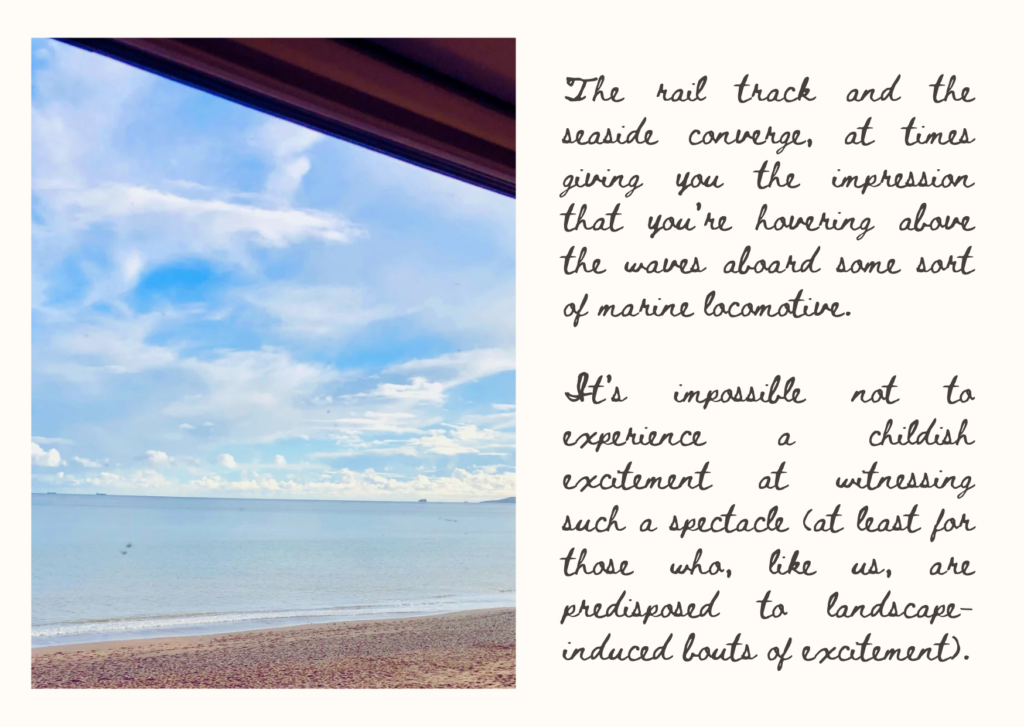
We arrive in Plymouth almost three hours after we boarded, and jump into a taxi that seems almost as eager to take us to our destination as we are to reach it (and we are very eager). Our Romanian taxi driver is very well versed in local history and he kindly summarises the most salient events that befell the city. Thus, in 15 minutes, as we journeyed from the station to the gates of Boringdon Hall, the city burned and was rebuilt, the Mayflower sailed and returned, pirates and explorers came and left their mark, Pocahontas passed through, as did Napoleon, and the city was devastated by the Blitz and reconstructed again. But all of this is left behind as we enter the manor’s meandering driveway, where the trees and shrubs crowd around us on either side of the road, leaning in as if to greet us with curiosity.
Every tale of the past is definitively archived in our minds as the main building comes majestically into view. Our luggage is taken inside, but it’s a good while before we join it because we simply have to admire the magnificent Boringdon Hall exterior from several angles before our awe subsides a little. Immersed as it is in greenery from all sides, it gives us the impression, for the second time that day, of accessing a dreamlike scene – but on this occasion it is more reminiscent of a fairytale. Perhaps it’s no coincidence that the name Boringdon comes from the Saxon “Burth-Y-Don,” which means “enchanted place on the hill.” Anxious to see the tale unfold, we enter. The procedural task of checking in is made far more pleasurable with the arrival of a refreshing elderflower drink. We sit down and sip as we start absorbing the building’s historical charm which seems to be oozing from the furniture and the very stonework.
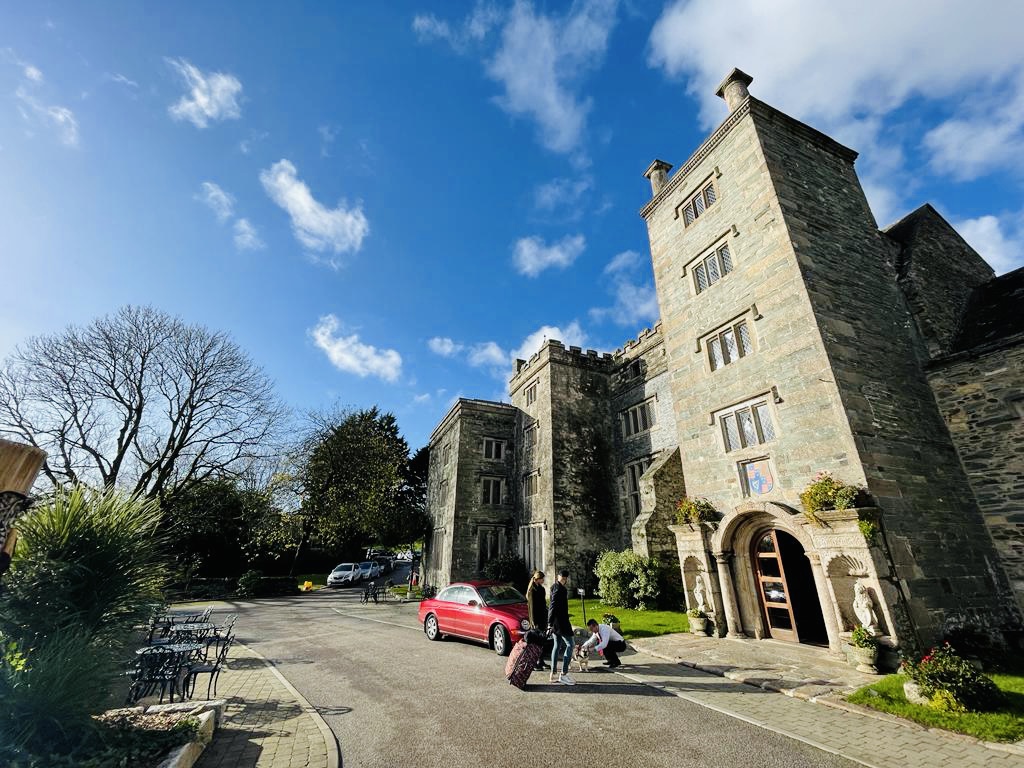
The Domesday Book (the oldest government record of all the towns in England) shows that a permanent building has existed on this spot for centuries. Known as Boringdon Hall since the 1580s, it saw many distinguished guests over the years, including Queen Elizabeth I who visited in 1588. It has changed ownership several times, going from King Edgar to the priory in the year 956 AD and back to the Crown in 1539 (with Henry VIII’s dissolution of the monasteries) when it was granted to the monarch’s courtier, the Earl of Southampton. Each subsequent owner had a different vision for the manor, so Boringdon went from royal property to farmhouse, to National Trust building to hotel, among other things. The manor survived political turmoil, semi destruction in the 1642 civil war, various declines and re-births and a couple of major fires. Finally, in the past decade it arose once again as a glorious hotel, with the addition of spectacular modern amenities. Looking at it now, it’s impossible to imagine a better use for it than allowing visitors to stay under its roof overnight to fully enjoy its atmosphere. And if they’re anything like us, patrons can fancy themselves guests of some royal banquet of bygone times.

As we are led to our room we are left speechless upon passing through the Great Hall. The first thing to capture our attention in this majestic room is an enormous fireplace that emanates not only heat but also plenty of charm. Above the mantelpiece is an imposing King James I’s coat of arms carved into the wall. Sunbeams stretch onto the floor through beautiful mullion windows, and a symphony of wood and stone lends instant cosiness, inspiring a desire to occupy one of the sofas and never leave. The Great Hall serves as a lounge area and bar, so we promise ourselves to schedule lounging and drinking into our plans as soon as practicable. But now it’s time to get to know our room, where we are pleased to be greeted by a four-poster bed, a freestanding bath, a stone fireplace and two glasses of champagne bubbling with excitement, just like us. We start with a toast and, glass in hand, inspect the finer details of the furniture as if perusing the artwork of an artist at a gallery.
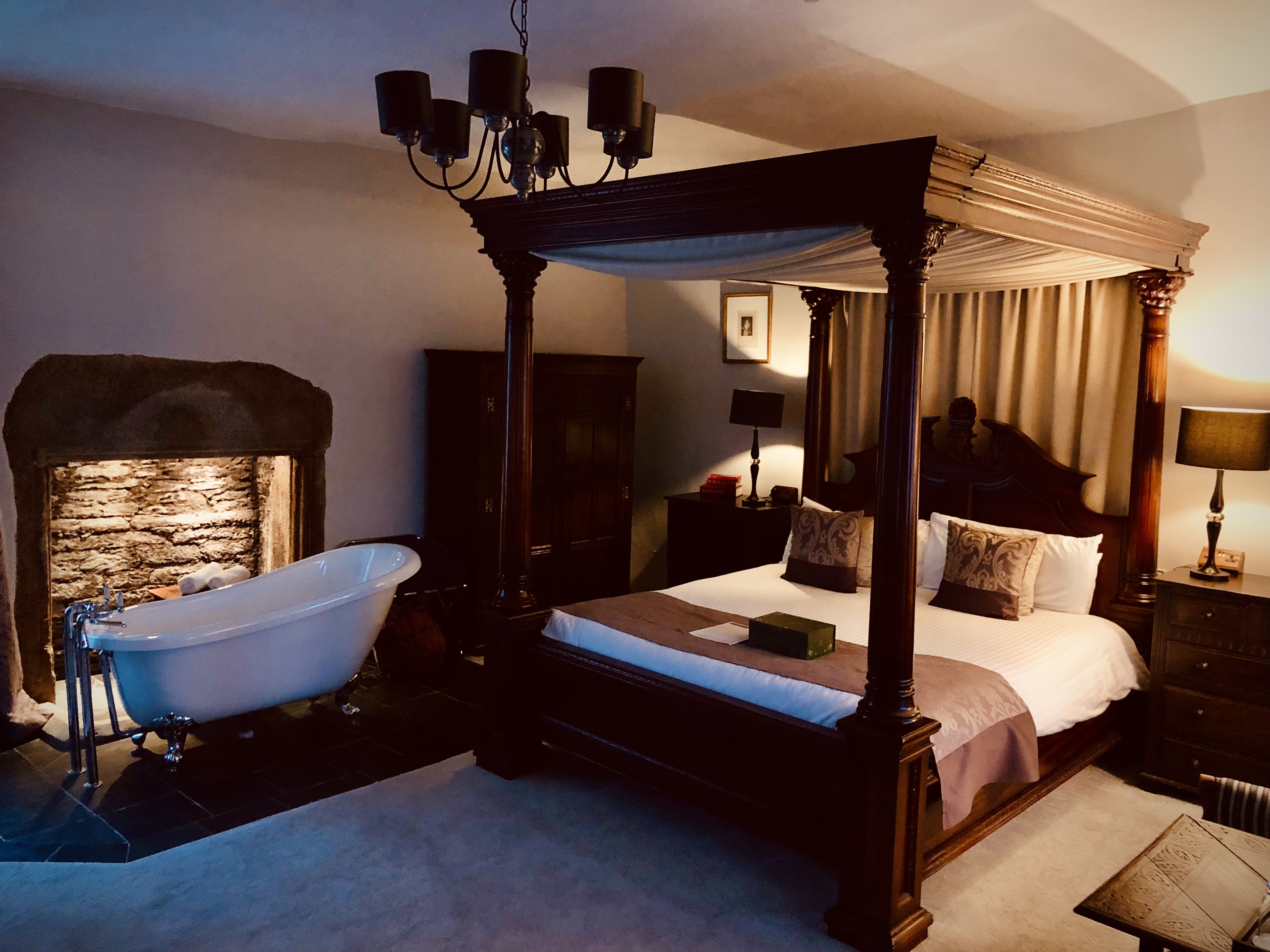
When you have free time before dinner and you also have access to an award-winning Spa, there is no room for debate about what your first activity should be. Gaia Spa is a recent addition to Boringdon and it’s housed within a modern wing that can be accessed via the hotel. Donning the fluffy white bathrobes and slippers provided, we explore this much talked about haven of wellbeing and can immediately see why it’s considered one of the best. Aside from a pool and a number of steam rooms, sauna and gym, the feature that most stands out for us is the hydrotherapy pool which affords a full view of the garden surrounding it. Best of all, part of this pool extends outdoor, so we could enjoy the fresh air on our faces as we soaked in the temperate waters. We also ordered a drink to sip whilst thus immersed, because such little luxuries are hard to turn down, and because they constitute unrefutable proof that you are indeed out of the office and in an undeniable state of relaxation. After some time, and only once we were fully convinced that the pool would still be here tomorrow morning and that we could return to it then, we headed back to our room to dress up and try to look as good as our evening meal promised to be. This was quite a challenge because the meal would be provided by Àclèaf, Boringdon’s Michelin starred restaurant.
Headed by chef Scott Paton, Àclèaf (meaning oak leaf in Old English) is a fine-dining gem that opened in 2020 and quickly became a standout restaurant in the region and beyond. We happen to be visiting on a special night, as it’s the launch of a book that generously shares the restaurant’s best recipes. We meet everyone at the Great Hall bar for a drink and then head upstairs and find that Àclèaf’s tables are on a mezzanine overlooking the very same hall we just left, only it looks even more stately now with the warmly lit chandelier above it dominating the view. To give us a proper introduction to Àclèaf, we are offered a tasting menu that showcases Paton’s style and ethos and takes into account seasonability while paying special regard to the aesthetics of each plate. The other protagonists of the night are a set of exceptional accompanying wines by Kent based producers Gusbourne.
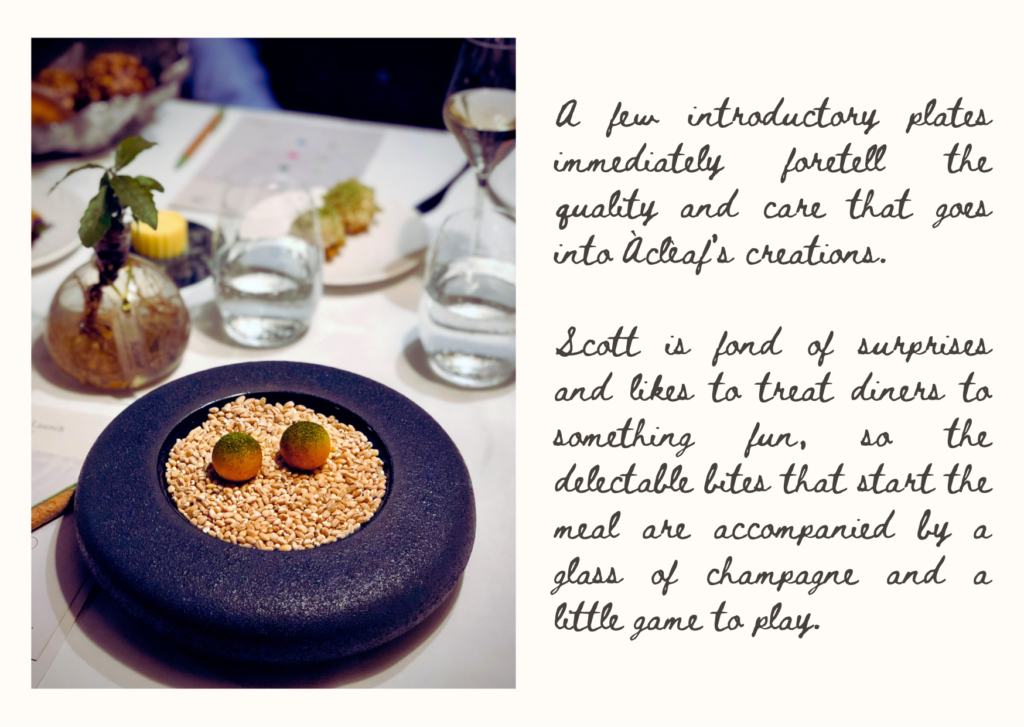
The little joys of the preceding hours have placed us in the best mood to savour the experience, which unfolded as follows. A few introductory plates immediately foretell the quality and care that goes into Àclèaf’s creations. Scott is fond of surprises and likes to treat diners to something fun, so the delectable bites that start the meal are accompanied by a glass of champagne and a little game to play. A simple psychology test which involves circling your preferred elements on a card seems to be just a bit of entertainment, but it is actually used to determine the ingredients and tasting profile of an unexpected, off the menu treat served later on. But here comes the first headlining dish on the night: the chicken liver and Pedro Ximenez jelly. It’s a neat teardrop of delightful flavours boasting an incredibly smooth texture, accompanied by a laminated brioche and chicken fat butter. An inspired meeting of sweet, savoury, fatty and silky goodness.
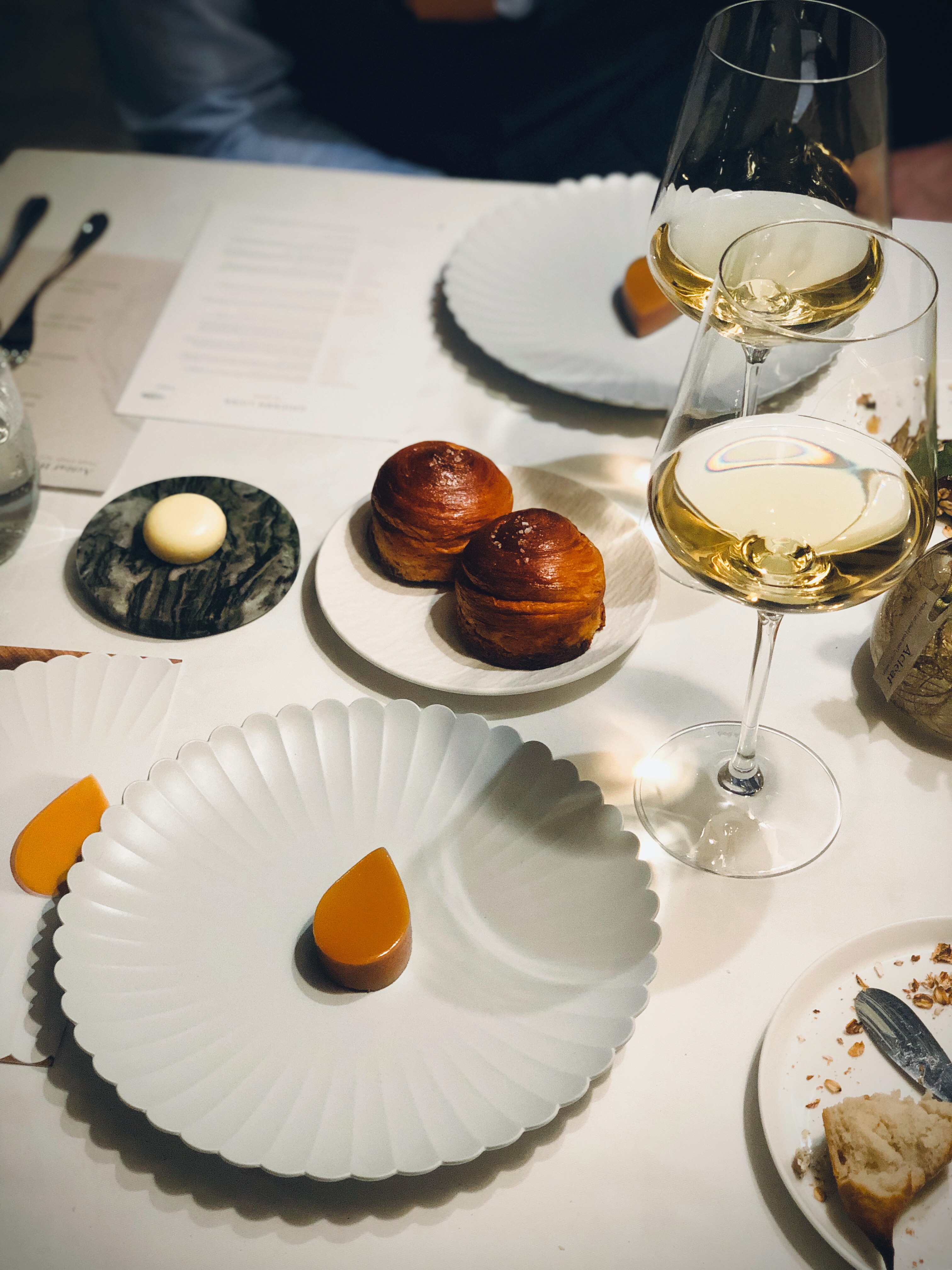
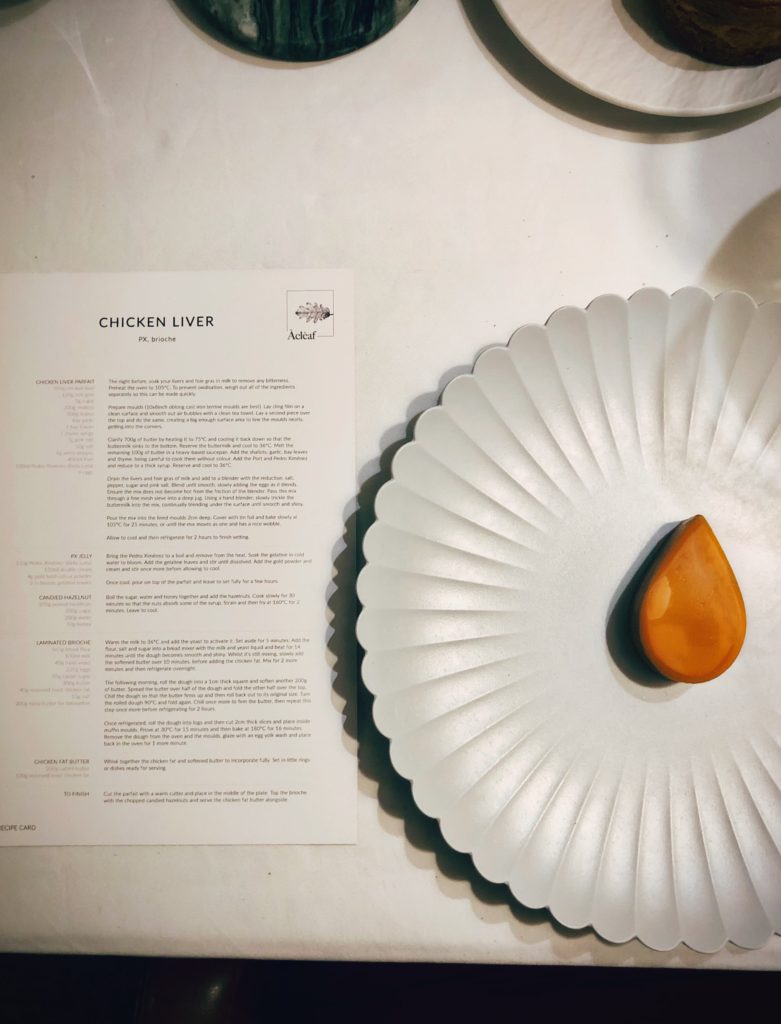
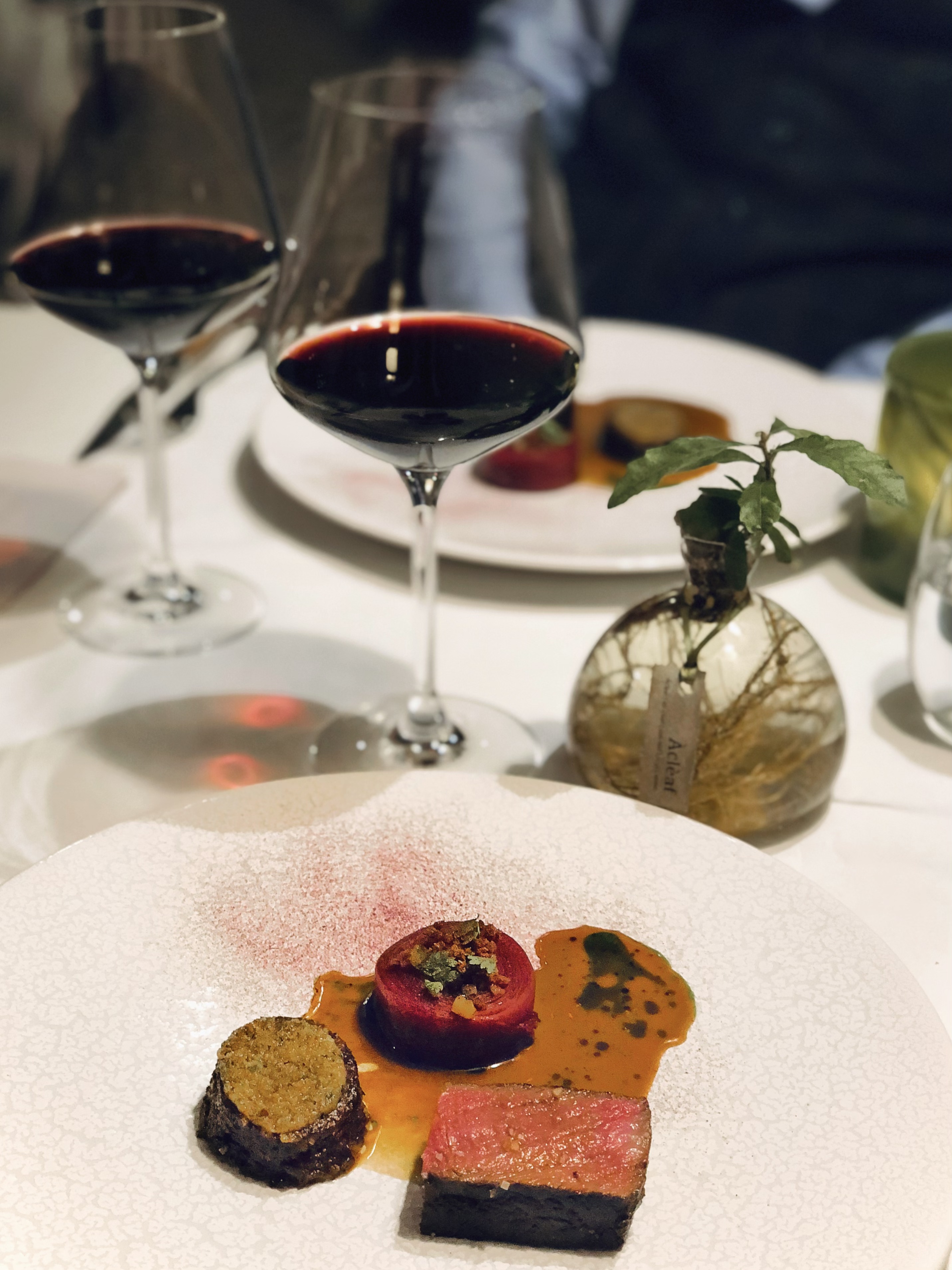
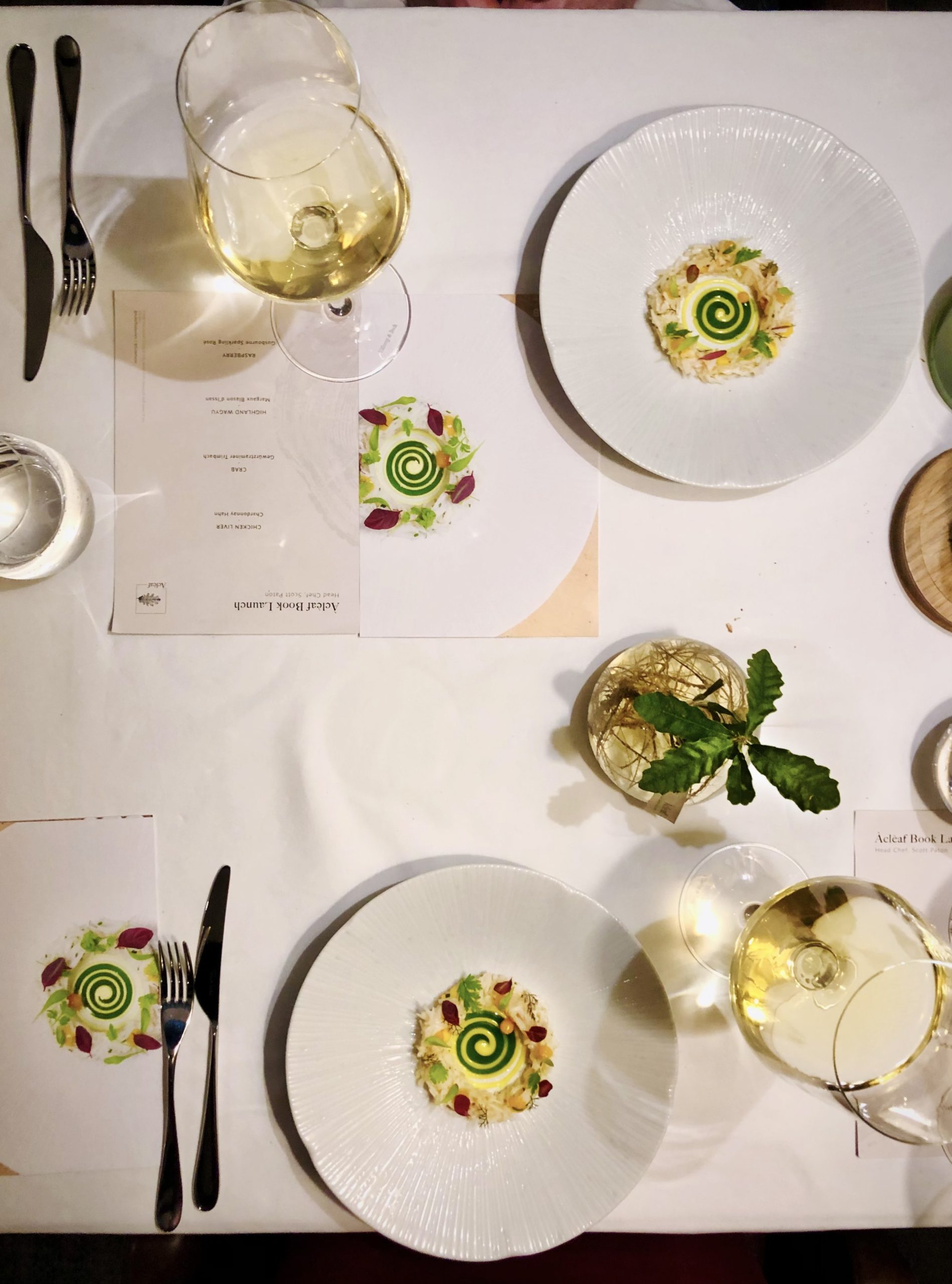
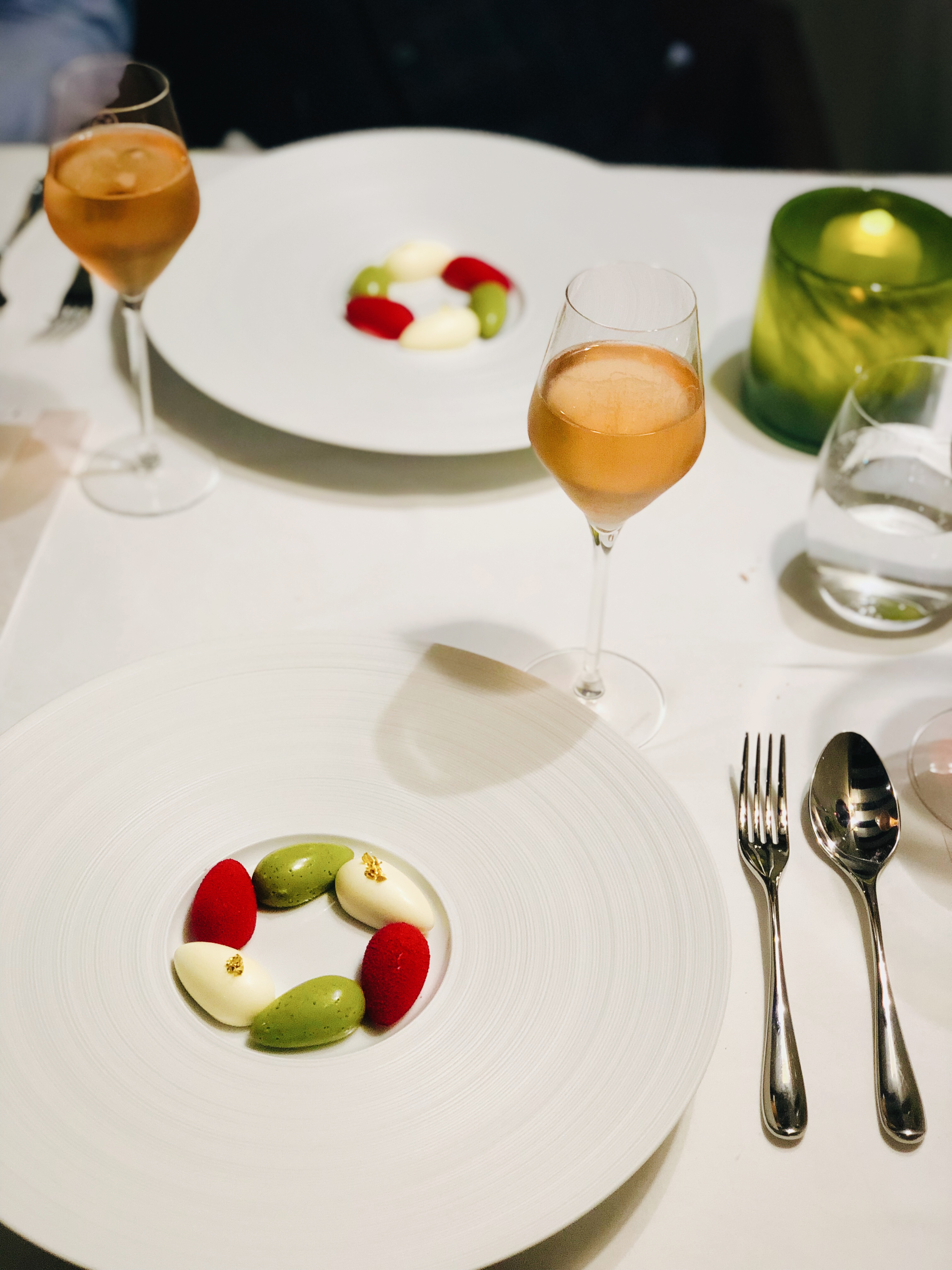
Just like divas intent on upstaging one another, next in line is a tender wagyu prepared to perfection, coupled with thin sheets of beetroot delicately rolled into a multilayered wheel. Next comes an attractive crown of crab with a colourful swirl of curry emulsion and coriander oil at its centre – arguably the prettiest dish on the menu and the most mesmerising. The dessert is composed of a raspberry, pistachio and white chocolate trio of oval shaped parfaits, bursting with flavour and very balanced in terms of sweetness. Although this was officially the last dish on the menu, it was followed by petit fours and preceded by a pre-dessert based on the answers given at the start of the meal and thus tailored to each individual. We did indeed receive different flavour combinations from one another and they were ones we approved of.

Elated by the meal, we go to thank Scott who speaks of his creations humbly. It’s clear that a lot of fun is involved in transforming his ideas and experiments into the perfectly formed menu stars that were shining on our table. We wrap up our evening with words of gratitude, but we are not quite ready to call it a day and so we linger in the Great Hall (as promised). We engage in a thorough analysis of our dinner, which we feel deserves some post-meal appreciation too. When it’s time to go back to our room, the walk is not just a means to an end: we admire tapestries, stop by the charming little nooks, smile as we cross stone archways and, somehow, the fascination for beamed walls doesn’t subside with repeated exposure to them. In spite of the late hour, I decide that a soak in the freestanding bathtub is just what my heart desires, and so the day ends with one more indulgence met, while reveries of the building’s history are reawakened by the visible signs of the room’s ancient past.
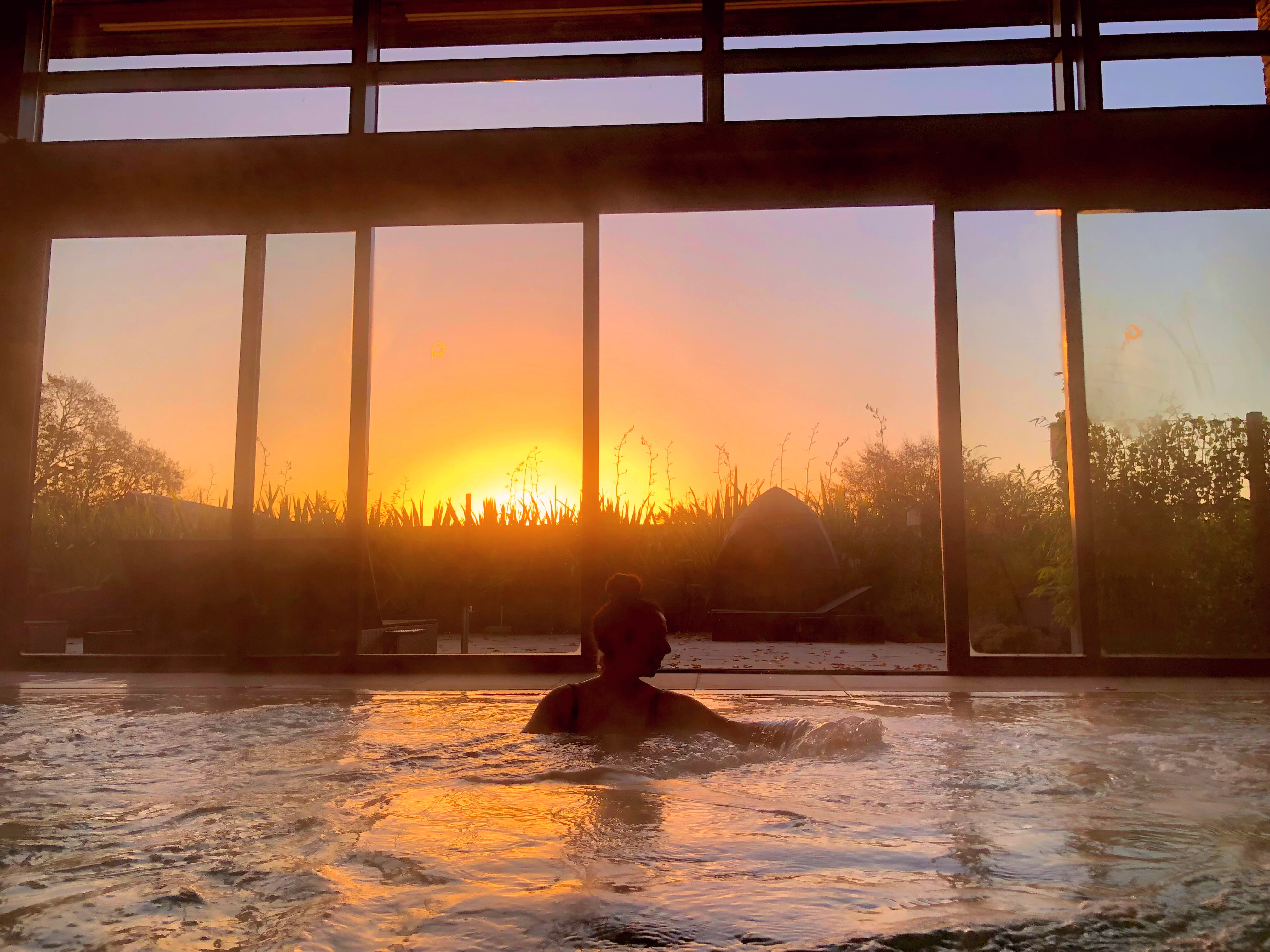
Early the next morning we are reunited with the dreamy scene of Gaia’s pool looking onto the garden. The sun is rising in the sky and painting it a pinky orange. The steam ascending from the pool makes the moment even dreamier, almost ethereal. We welcome the new day from this vantage point and wrap up the view in an imaginary bundle to be carried home with us. We’ve unwrapped this memory many times since, and with it the woody scent of the Great Hall’s fireplace and the peculiar sensation that Boringdon’s walls and windows and doors were inhabiting the space as silent observers rather than inanimate objects. Perhaps they stored an impression of us, as we have of them, and maybe they hold a memory of countless other guests, ancient and modern. We now fancy that by staying here, we have somehow become part of Boringdon’s enchanting history.
Photo Credit: Mersa Auda
— Mersa Auda

